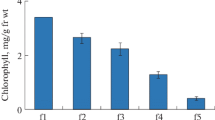Abstract
Polyclonal antibodies against castor-oil seed cytosolic and leucoplastic pyruvate kinases (PKc and PKp, respectively; EC 2.7.1.40) were utilized to examine the subunit compositions and developmental profiles of canola (Brassica napus L. cv. Topas) PKc and PKp over 6 d of seed germination and 35 d of culture of microspore-derived embryos. The PKc from germinating seeds appears to be composed of a single type of 56-kDa subunit, whereas the enzyme from cultured embryos contains equal proportions of immunologically related 57- and 56-kDa subunits. The PKp was immunologically undetectable in germinating seeds, while the enzyme from cultured embryos consisted of immunologically related 64- and 58-kDa subunits in a ratio of about 1∶2, respectively. The large increase in PK activity that occurs between the second and fourth days of seed gemination is based upon de-novo synthesis of PKc. Between 7 and 14 d of culture of microspore-derived embryos, the levels of PKp and PK maximal activity increased approx. 3- and 2.5-fold, respectively. These increases were coincident with an approximately fourfold rise in the in-vivo pyruvate: phosphoenolpyruvate concentration ratio. Conversely, PKc was not only far less abundant relative to PKp, but its level remained constant over 35 d of microspore-embryo culture. Developing non-zygotic (microspore-derived) embryos strongly resembled ripening zygotic (seed) embryos in terms of PK specific activity as well as relative amounts and subunit compositions of PKc and PKp. The results indicate that the synthesis of PK isoenzymes in B. napus seeds is highly regulated and that this regulation follows a preset developmental program.
Similar content being viewed by others
Abbreviations
- IgG:
-
immunoglobulin G
- IU:
-
international unit
- PEP:
-
phosphoenolpyruvate
- 3-PGA:
-
3-phosphoglycerate
- PK(s):
-
pyruvate kinase(s)
- PKc :
-
cytosolic pyruvate kinase
- PKp :
-
plastidic pyruvate kinase
- PYR:
-
pyruvate
References
Battey, J.F., Schmid, K.M., Ohlrogge, J.B. (1989) Genetic engineering for plant oils: Potentials and limitations. Trends Biotechnol. 7, 122–126
Bewley, J.D., Black, M. (1985) Seeds: Physiology of development and germination. Springer-Verlag, Heidelberg, Germany
Blair, J.B. (1980) Regulatory properties of hepatic pyruvate kinase. In: The regulation of carbohydrate formation and utilization in mammals, pp. 121–151, Veneziale, C.M., ed. University Park Press, Baltimore, Md., USA
Blakeley, S.D., Plaxton, W.C., Dennis, D.T. (1990) The isolation, sequencing and characterization of cDNA clones for the cytosolic isozyme of plant pyruvate kinase. Plant Mol. Biol. 15, 665–669
Blakeley, S.D., Plaxton, W.C., Dennis, D.T. (1991) Relationship between the subunits of leucoplast pyruvate kinase from Ricinus communis and a comparison with the enzyme from other sources. Plant Physiol. 96, 1283–1288
Botha, F.C., Dennis, D.T. (1987) Phosphoglyceromutase activity and concentration in the endosperm of developing and germinating Ricinus communis seeds. Can J. Bot. 65, 1908–1912
Bradford, M.M. (1976) A rapid and sensitive method for the quantitation of microgram quantities of protein utilizing the principle of protein-dye binding. Anal. Biochem. 72, 248–254
Dennis, D.T., Miernyk, J.A. (1982) Compartmentation of non photosynthetic carbohydrate metabolism. Annu. Rev. Plant Physiol. 33, 27–50
Hatzfeld, W-D., Stitt, M. (1991) Regulation of glycolysis in heterotrophic cell suspension cultures of Chenopodium rubrum in response to proton fluxes at the plasmalemma. Physiol. Plant. 81, 103–110
Ireland, R.J., De Luca, V., Dennis, D.T. (1980) Characterization and kinetics of isozymes of pyruvate kinase from developing castor bean endosperm. Plant Physiol. 65, 1188–1193
Knowles, V.L., Dennis, D.T., Plaxton, W.C. (1989) Purification of a novel pyruvate kinase from a green alga. FEBS Lett. 259, 130–132
Lin, M., Turpin, D.H., Plaxton, W.C. (1989a) Pyruvate kinase isozymes from the green alga, Selenastrum minutum. I. Purification and physical and immunological characterization. Arch. Biochem. Biophys. 269, 219–227
Lin, M., Turpin, D.H., Plaxton, W.C. (1989b) Pyruvate kinase isozymes from the green alga, Selenastrum minutum. II. Kinetic and regulatory properties. Arch. Biochem. Biophys. 269, 228–238
Perl, M. (1980) Enzyme activities involved in ATP synthesis in seeds. Israel J. Bot. 29, 307–311
Plaxton, W.C. (1988) Purification of pyruvate kinase from germinating castor bean endosperm. Plant Physiol. 86, 1064–1069
Plaxton, W.C. (1989) Molecular and immunological characterization of plastid and cytosolic pyruvate kinase isozymes from castor-oil-plant endosperm and leaf. Eur. J. Biochem. 181, 443–451
Plaxton, W.C. (1991) Leucoplast pyruvate kinase from developing castor oil seeds.Characterization of the enzyme's degradation by a cysteine endopeptidase. Plant Physiol. 97, 1334–1338
Plaxton, W.C., Dennis, D.T., Knowles, V.L. (1990) Purification of leucoplast pyruvate kinase from developing castor bean endosperm. Plant Physiol. 94, 1528–1534
Podestá, F.E., Plaxton, W.C. (1991) Kinetic and regulatory properties of cytosolic pyruvate kinase from germinating castor oil seeds. Biochem. J. 279, 495–501
Pomeroy, M.K., Kramer, J.K.G., Hunt, D.J., Keller, W.A. (1991) Fatty acid changes during development of zygotic and microspore-derived embryos of Brassica napus. Physiol. Plant. 81, 447–454
Taylor, D.C., Weber, N., Underhill, E.W., Pomeroy, M.K., Keller, W.A., Scowcroft, W.R., Wilen, R.W., Moloney, M.M., Holbrook, L.A. (1990) Storage-protein regulation and lipid accumulation in microspore embryos of Brassica napus L. Planta 181, 18–26
Turpin, D.H., Botha, F.C., Smith, R.G., Feil, R., Horsey, A.K., Vanlerberghe, G.C. (1990) Regulation of carbon partitioning to respiration during dark ammonia assimilation by the green alga, Selenastrum minutum. Plant Physiol. 93, 166–175
Vanlerberghe, G.C., Feil, R., Turpin, D.H. (1990) Anaerobic metabolism in the N-limited green alga Selenastrum minutum I. Regulation of carbon metabolism and succinate as a fermentation product. Plant Physiol. 94, 1116–1123
Wu, F.S., Wang, M.Y. (1984) Extraction of proteins for sodium dodecyl sulfate-polyacrylamide gel electrophoresis from protease rich plant tissues. Anal. Biochem. 139, 100–103
Author information
Authors and Affiliations
Additional information
Plant Research Centre contribution No. 1374
We wish to thank Ms. Kathryn Hovey and Ms. Suzanne Belliveau (Agriculture Canada) for their expert assistance in the culturing and harvesting of microspore-derived embryos of canola. This work was supported by a Strategic Grant from the Natural Sciences and Engineering Research Council of Canada.
Rights and permissions
About this article
Cite this article
Sangwan, R.S., Gauthier, D.A., Turpin, D.H. et al. Pyruvate-kinase isoenzymes from zygotic and microspore-derived embryos of Brassica napus . Planta 187, 198–202 (1992). https://doi.org/10.1007/BF00201938
Received:
Accepted:
Issue Date:
DOI: https://doi.org/10.1007/BF00201938




